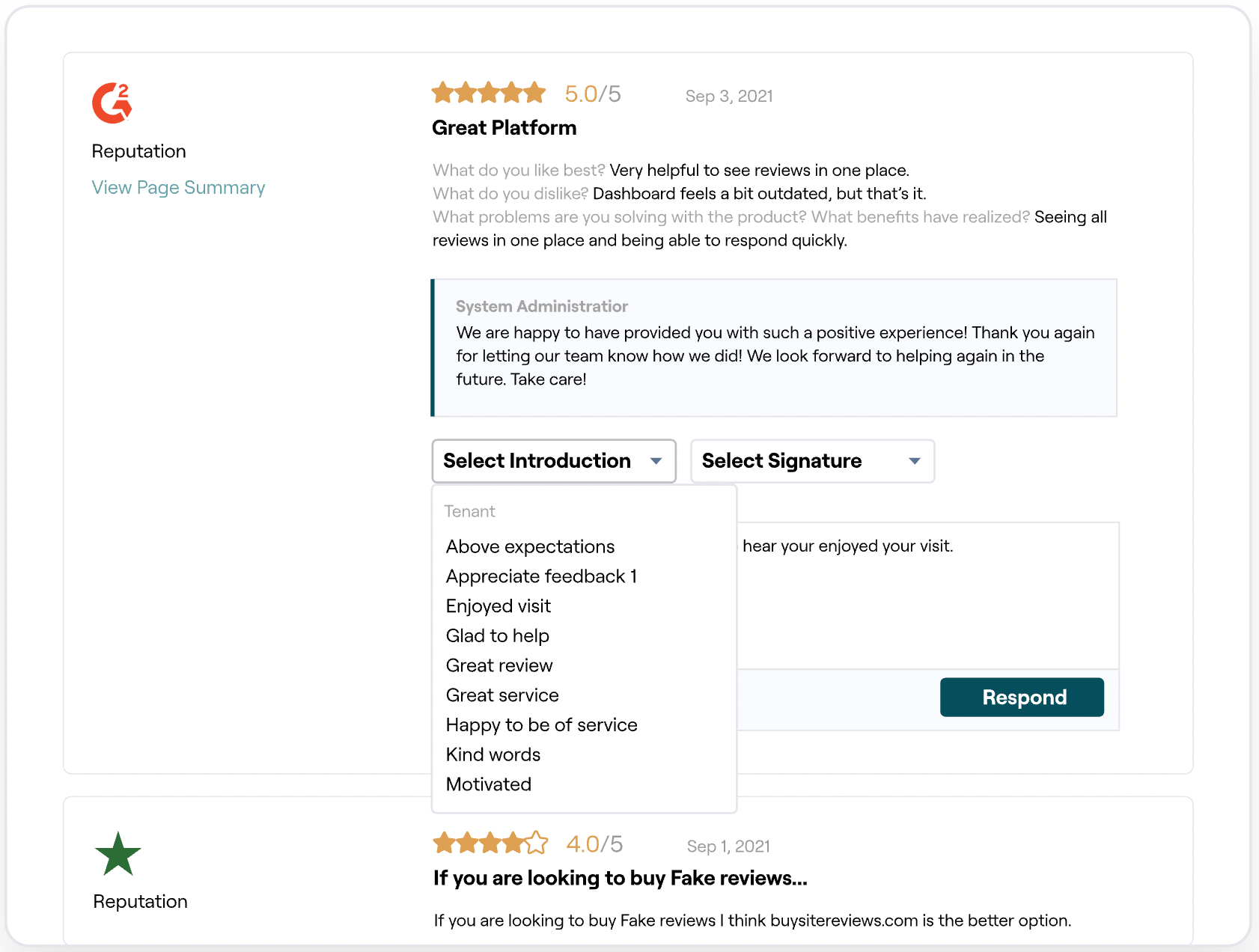A 5-Step Guide to Improving Your Online Reputation
Adam Dorfman

Introduction
When it Comes to Brand Perception, You’re No Longer in Control
The balance of power has shifted from brand owners to customers, and what people say about you online can either derail your business or accelerate its success. This is especially true for consumer-focused brands in industries such as retail, hospitality, automotive and healthcare.
This guide will help you understand the role of online reviews in overall brand health, and the tactics to maximize your online reputation.
Online Reviews Have a Direct Impact on Business Performance

As consumers increasingly rely on online tools to guide their purchasing decisions, reviews and ratings have a dramatic impact on your ability to be seen and selected. Here’s why:
- People Use Online Reviews to Make Choices. The vast majority — 87 percent in one recent survey — of Americans trust online reviews to help them choose which local businesses or services to use. And 88 percent of consumers have avoided a company because of a bad review.
- Google Uses Online Reviews to Rate You. Google uses the arithmetic average to calculate the average rating of a business. The more positive reviews you have, the higher your average rating will be.
- Your Ratings Determine Your Search Rankings. According to SEO consulting company Moz, review signals — which include review quantity and recency — are important page ranking factors. Google and other search engines determine where to rank you on results pages and in local search results based on these signals.
- Recent Reviews Build Consumer Trust in Your Brand. Search Engine Land reports that 69 percent of consumers think reviews older than three months are no longer relevant. And, if your locations don’t have a lot of recent reviews, they’ll rank lower in “near me” search — and they may not even show up on the map.
- Businesses with Better Reviews Increase Revenue. Reputation tracked point-of-sale data for over 1,800 U.S. dealerships and found that an increase in Reputation Score of 150 points led to a 6-percent increase in average seasonally-adjusted sales. Conversely, a drop of 150 points correlated with a decline in sales volume of 13 percent.
Related: Using Data To Boost Hospitality Business Performance
Technology Enables Online Review Management at Scale
If yours is a large organization, manually monitoring and responding to reviews in a timely manner across many review sites and social networks is simply not scalable. Technology is necessary to manage online reputation at scale, coupled with a structured process.
What’s in this Guide?
You’ll learn about a proven approach to successful Online Reputation Management (ORM) that includes the following steps:
- Systematically monitor and respond to reviews
 Increase review volume to reflect true customer sentiment
Increase review volume to reflect true customer sentiment- Elevate star ratings and rankings to drive business opportunities and revenue
- Showcase good reviews and ratings on your company website and in marketing materials
- Use insights gleaned from reviews to optimize your customer’s experience online and onsite
1. Systematically Monitor and Respond to Reviews
Monitoring
Online reviews provide a wealth of customer experience data and can help you quickly uncover issues that have a negative impact on your business — provided you have a systematic method in place to track and listen to that feedback. Monitoring what people say about your business is the critical first step to creating a virtuous cycle that delivers more positive reviews, higher overall ratings and rankings and, ultimately, more business.
Responding
Responding to customer reviews — especially the negative ones — is an essential step in building consumer trust in your brand. PeopleClaim found 95 percent of unhappy people will return to a business if an issue is resolved quickly and efficiently
Related: 6 Solid Ways to Turn Negative Reviews into Positive Reviews
Strategy
- Keep a close watch: As a baseline, monitor reviews on Google, Facebook and key industry review sites. All of them can significantly impact your business — so stay vigilant.
- Follow up: Respond quickly and professionally when reviews post anywhere on the web. Reputation’s Social Listening Team uses a four-hour benchmark to respond to negative reviews.
- Don’t miss a beat: Respond to 100 percent of all negative reviews and at least 20 percent of all positive reviews.
- Take it offline: When responding to negative reviews, take the discussion offline to resolve the problem or keep an argument from escalating.
- Technology is your friend: Even with the best of intentions, managing online reviews is unwieldy if handled manually; your results will be sporadic, inconsistent and hard to measure. Invest in tools that automate as much of this process as possible — from monitoring, to responding, to measuring effectiveness.
2. Increase Review Volume to Capture True Customer Sentiment
There’s Power in Numbers
Having lots of reviews improves customer trust in your brand. And if a few reviews are negative, don’t despair! People are more likely to trust your reviews if you include both the good and the bad.
Strategy
- Ask away: Make it a practice to request reviews from all your customers, immediately following interactions. You’ll get higher response rates and more detailed, actionable information.
- Offer multiple formats: Provide multiple ways for customers to provide feedback, such as text, email or kiosks. Be sure to select a method that’s appropriate for the interaction and the audience.
- Start with Google: SearchEngineWatch and Statista found 70-80 percent of consumer searches for businesses are now done via Google, Apple, Bing and Facebook.
Related: How to Remove Google Reviews: Management of Bad Feedback
Did You Know?
Reputation’s mobile app, Reputation Live, enables front-line reps to request reviews from customers while they’re still at the location — right on their smartphones — and follow up with a text message. Research shows review requests sent via SMS get 15X higher response rates.
3. Elevate Star Ratings and Rankings to Drive Business Opportunities and Revenue
You Can’t Win Customers if They Can’t Find You Online
Eighty percent of searches happen on map apps and search engines, and Google is the most popular in both categories. If you’re not in Google’s local 3-pack — the top three results and the only ones displayed on the map — customers will pass you by.
How do you make it to the top spots? A high volume of recent, high-quality reviews will bump you up. Google’s ranking algorithms take these factors into consideration, along with your locations’ average star ratings.
Strategy
- Build review volume: The more reviews you have, the higher your overall star ratings will be. Plus, review snippets appear in search results, helping customers choose you over competitors.
- Solicit reviews for all your sites: It’s great if you have a near 5-star rating for your company or your anchor locations. But if you don’t show up in the top three across all locations, you’re losing business opportunities to someone else.
- Focus on Google: Make sure a substantial number of your online reviews are submitted on Google since that’s where the majority of local traffic finds you.
- Don’t wait: Customers will write longer, more detailed reviews if you ask for them right after an interaction when the experience is fresh in their minds. The more detailed the review response, the more heavily it’s weighted in Google’s algorithms.
Related: How to Ask Customers for Reviews
4. Showcase Good Reviews and High Ratings on Your Company Website and in Marketing Materials
User-generated Content (UGC) is Powerful
According to Adweek, 93 percent of consumers find UGC to be helpful when making a purchasing decision. And online reviews are 100 percent UGC.
UGC on your website is even more valuable. It keeps site visitors engaged for longer and provides a natural transition to product information or promotions, leading to higher conversion rates.
Strategy
- Use technology: A good online reputation management (ORM) platform will enable you to stream reviews directly to your website. This in turn will give your location web pages a SEO bump and further increase their “findability.”
- Keep reviews coming: Don’t let your UGC grow stale; use the methods explained in this eBook to systematically request reviews and elevate your ratings.
- Solicit reviews instead of case studies or formal quotes: Content from reviews is in the public domain, so you are free to quote it on your site or in marketing materials. Rather than wait for the perfect customer testimonial, you can quickly build a stable of comments and quotes.
Next Steps
- Do surveys the right way: Build and send out customer satisfaction surveys that are true to brand, customizable and work beautifully on browsers, kiosks and mobile devices.
- Improve operations: Sentiment analysis tools and tornado charts can clearly identify strengths and weaknesses in the way your locations interact with customers.
- Know where you stand: Leverage competitive benchmarking tools to understand how your locations are performing relative to local competitors.
- Report on findings: Share insights by compiling and delivering customized reports to key stakeholders at a regular cadence.
- Technology is your friend (again!): ORM platforms apply sophisticated machine learning algorithms to free text found in online reviews, yielding insight and learning that’s not otherwise easily uncovered. Combined with analytics and reporting tools, these platforms can help you identify, quantify and prioritize customer satisfaction issues that are affecting your reputation and your bottom line.
5. Use Insights Gleaned from Reviews to Optimize Your Customer’s Experience Online and Onsite
Focus on the Customer
Research from Temkin Group revealed that a focus on customer experience gives companies a 16-percent advantage over competitors across a range of metrics, including a customer’s willingness to buy, reluctance to switch brands and likelihood to recommend. But how can you improve the customer experience without insights?
The value — and challenge — of freeform reviews is they can cover a breadth of topics relating to customer experience, from product value to wait time to staff and management competence. This information can help you quickly identify recurring issues and standardize best practices across your organization, and down at the location level — leading to a better overall experience for your customers.
Conclusion
Your Online Reputation is a Direct Proxy for Customers’ Buying Preferences
You simply cannot afford to ignore it. These five steps provide a framework for building trust, loyalty and advocacy among your customers, attracting new business and driving revenue growth.
Want to learn more? Check out our Online Reputation Management Starter Series:
Part 1: Getting Started with Online Reputation Management
Part 2: Which Online Review Sites Should I Monitor?
Part 3: Taking Action on Customer Feedback
Reputation can help you apply these steps with our comprehensive ORM platform, beginning with sound strategies for managing online reviews.

